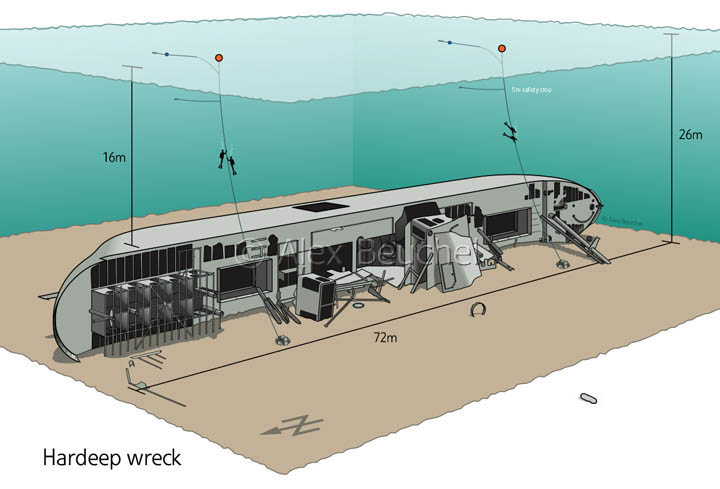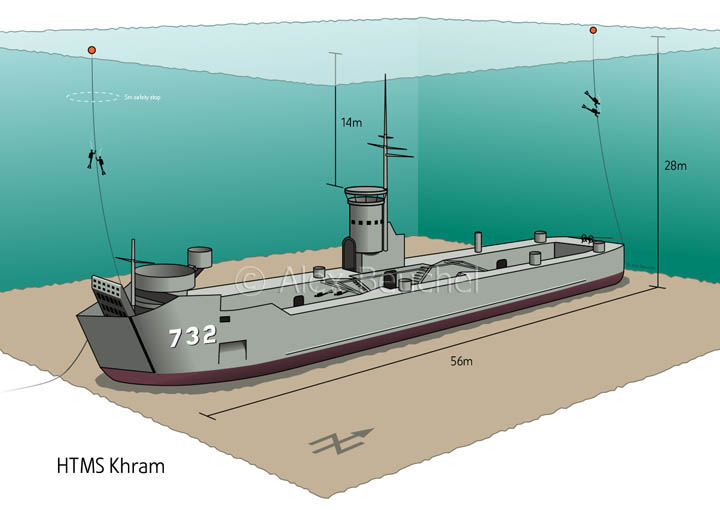Making High Resolution Dive Maps
Written by Stephen Burton


Here a few words on the story behind these maps:
In the course of my Dive Master training at, I was confronted with the task of creating a dive site map. This in itself is of course a rather simple thing to do and usually wouldn’t take more than 5 minutes to pass the requirement outlined by my instructor. However it sparked a personal challenge in me to combine my emerging passion for scuba diving with my graphic design abilities as I work for an advertising agency in Bangkok during week days.
As, of course, in the dive world Pattaya is known for its great ship wrecks, objects for my dive maps were easily found: the wreck of the HTMS Khram and the Hardeep wreck. The first one an easy task to achieve, the second one seemingly impossible.
As the Khram was purpose sunk in the beginning of 2003 to create an artificial reef and it being one out of over 550 ships of the same type ever built, visual reference material was readily available. Using existing photographs and only a few dives on the wreck to check for details, the map of the Khram was finished in no-time.
Unlike the Hardeep. With this vessel sunk over 60 years ago, no clear photographs nor any construction plans are known to exist. All you have to start with is a big wreck of a cargo ship at 26m depth in water with a 5-8m visibility. Previous drawings of the wreck were sufficient for dive briefs but lacked an exact scale and sense of proportion and detail needed to brief divers of varying degrees of wreck diving experience.
After just a few dives I gave up my first attempt at drawing the wreck on my dive slate in three dimensional perspective. Re-drawing my observations of individual sections on the computer back in Bangkok after each weekend of diving, I still was not satisfied with the overall proportions that showed. Things were still too random. The reasons for that were all apparent: narrow vision from the mask, distorted scales and sizes of everything through the water, a low visibility (you only see individual patches but never the context between them), the whole ship lays on its side so bulkheads become ceilings and decks become walls, a dive time of only a few minutes and all of it combined with effects of nitrogen narcosis. I may not have felt this playing Tic-Tac-Toe at 40m depth during my Deep Spec but trying to reverse-engineer this wreck under water I sure had to acknowledge that my brain was working at a slower pace.
The only viable option was to measure out the entire wreck with a measure tape to eventually come up with a two-dimensional ‘floor plan’
which would then form the basis of a three-dimensional illustration.
Over the course of many weekends together with a number of very patient dive buddies this mission was achieved. And diving the Hardeep had never been more interesting since all the sudden we were forced to study details that always went missing on a ‘regular’
dive.
Back in Bangkok I progressively placed all the collected data in a 1:100 scale computer design file. Only after this was completed I applied a three-dimensional rotation to the file of the upper deck to arrive at exactly the same perspective as the map of the Khram wreck.
Now my previous perspective underwater sketches all had reference points on which they could be attached to and it became clear in what direction they had to be enlarged or re-scaled.
Data retrieved in the lower deck served as basis for interior views of the cabins at the bow which can be penetrated in a variety of (narrow) ways but somehow always deterred divers from exploring them since there wasn’t much known or other divers that knew had difficulty explaining their structure.
Today the dive maps serve as invaluable aids to the dive briefs on the local dive boats. As a picture says more than a thousand words, even divers with no previous wreck diving experience gain full understanding and confidence in diving the wrecks. Furthermore, even divers that have visited the Hardeep many times before can now plan dives to very specific portions of the wreck and explore them in detail.
(Alex Beuchel, DiveMaster, February 2005)